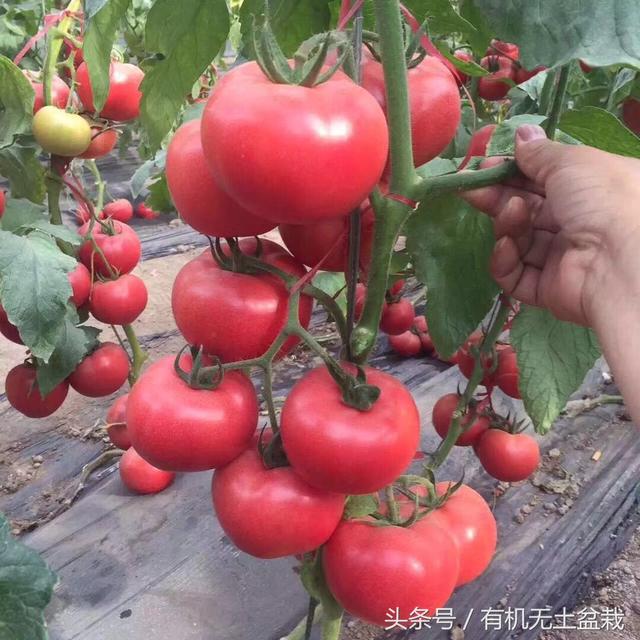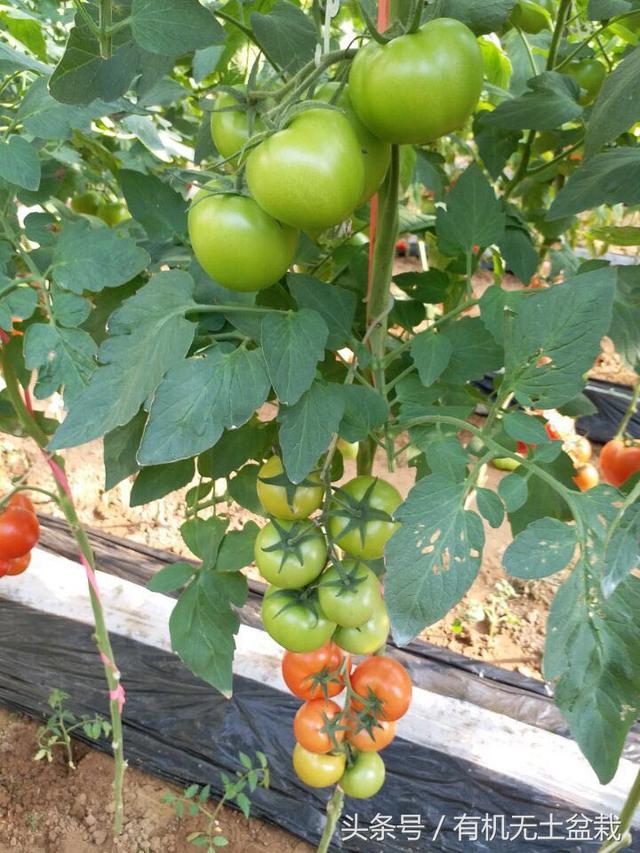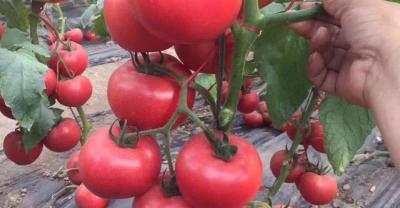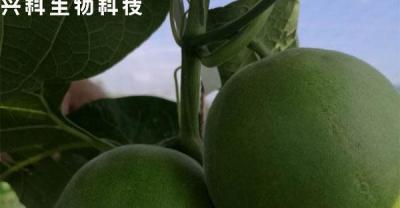Tomato planting method and time: how to grow tomato? How to manage fertilization at Seedling stage in Tomato Seedling stage
The root system of tomato is well developed, and the capillary root that absorbs nutrients is mainly distributed in the tillage layer of 30 cm, the deepest part can reach 1.5 meters, and the diameter of the root group can reach 1.3-1.7 meters. The root regeneration ability is very strong. After the main root is truncated in the process of seedling transplanting, more lateral roots will be sent out, so that the absorption capacity of the whole root system will be enhanced. Therefore, the requirements of the soil in the planting process are not particularly strict. Generally speaking, it can be planted except for low-lying waterlogged land and saline-alkali land. However, in order to obtain high-quality and high-yield tomatoes, it is best to choose slightly acidic sandy soil with loose and fertile soil and PH value of 6-6.5 for water and fertilizer conservation.

In addition, tomato likes to be warm, and the suitable temperature is 25-28 ℃ in daytime and 16-18 ℃ at night. Too low or too high will affect the quality of tomatoes. When the temperature is lower than 15 ℃, the germination of tomato seeds will be blocked and pollination and color change will also be affected. When the temperature is below 10 ℃, the tomato will grow slowly and the reproductive development will be inhibited. When it is below 5 ℃, the stem and leaf will stop growing, 2 ℃ will produce freezing injury, and 0 ℃ will be frozen to death. Higher than 35 ℃ will also affect reproductive development, and higher than 40 ℃ will be killed by heat. The appropriate temperature difference is beneficial to the accumulation and ripening of nutrients, promote the healthy development of tomato, prevent overgrowth, enhance the disease resistance and stress resistance of tomato, and improve the yield.
1. In general, according to the time of planting and harvest, tomatoes can be divided into four categories: spring tomato, autumn and winter stubble, winter and spring stubble and overwintering stubble.
1. Sowing time of spring tomato
Spring tomato was sown from late January to early February and planted from late February to early March.
2. Sowing time in autumn and winter
Autumn and winter stubble is generally sown and raised seedlings from mid-late July to early August, colonized from mid-late August to early September, and buckled from mid-late September to early October. Harvest from late November to early February of the following year.
3. Sowing time in winter and spring
The winter and spring stubble was sown from early November to early December, planted from mid-late January to early February the following year, and harvested from mid-March to June.
4. Sowing time of overwintering stubble
Overwintering stubble belongs to a big stubble cultivation, usually from mid-late September to early October, planting in November, and harvesting in January of the following year.

II. Tomato seedlings
1. Seminal nail can be used for seed disinfection. Azoxystrobin can also soak the seeds in warm water directly. The seeds can be soaked in 55 ℃ of warm water for 15-30 minutes to kill the germs on the surface of the seeds and remove the withered and damaged seeds.
2. For the selection of seedling tray, the seedling tray with 50 or 72 holes can be selected to raise seedlings. The substrate is usually used to raise seedlings, and the commonly used substrate is made of perlite, vermiculite and peat, and the proportion method is 1:1:10. Carbendazim or carbendazim and other drugs can be added to the matrix to prevent seedling diseases.
3. Sowing, after loading the seedling substrate in the seedling tray, you can press out a depression 0.5 cm deep, then sow, and cover it with a layer of vermiculite after sowing. In order to play the role of heat preservation and water conservation.
4. After watering and sowing, the seedling tray can be placed on the seedling bed, and the height of the seedling bed should be about 1 meter from the ground to prevent rats and pests from nibbling seeds. In addition, rats are prevented from being caught in cages around. When everything is ready, you can water it. The first watering must be thoroughly watered, which is conducive to seed germination and normal growth.
III. Management at the seedling stage
The main results are as follows: 1. Temperature management, the temperature in the seedling shed is controlled at 25-28 ℃ in the daytime and 18-20 ℃ at night. When the seedlings grow to two true leaves, the seedlings can be trained properly. The seedlings can be trained at low temperature, the night temperature can be controlled at 15-18 degrees to grow at the top, and the root growth can be promoted by proper water control.
2. Disease management
The main diseases of seedlings are standing blight and quenching. Drug prophylaxis can be carried out after the seedlings are unearthed. The available drugs are prednisone and carbendazim, which are sprayed every 5-7 days and diluted by 1500-2000 times.
3. Fertilizer use
Foliar fertilizer is mainly used to supplement nutrition at seedling stage, which can be fertilized after two real leaves of tomato. Baolifeng and Magic 18-18-18 balance fertilizer can be sprayed on the leaves after dilution, the multiple of dilution is 2000-2500 times, once every 10 days.

IV. Soil preparation
Tomato planting sites should choose plots that have not been planted with eggplant crops before. Before planting, apply sufficient base fertilizer, each mu can use fully mature organic fertilizer (cow manure, sheep manure, pig manure) 1000-1500 kg, biological bacterial fertilizer 200kg. Then 50 kg of calcium carbonate and 50 kg of compound fertilizer are mixed and sprinkled on the ground, and then mixed into the soil. The size of the bed can be 1.3-1.7 meters. The planting density is 2000,2700 plants per mu. The planting specification is double-row planting in each row, the plant spacing is 25 cm 40 cm and the row spacing is 40 cm 50 cm. Double-culm pruning, fertile land, vigorous varieties can be sparsely planted, plant spacing 30cm-40cm; single-culm pruning, suitable close planting, plant spacing 25cm-30cm. In addition, the seeds should be planted sparsely in winter and spring, close in autumn, sparse in fertile land and close in thin land.
5. Transplanting
The seedlings can be transplanted in the field when the growth cycle of the four leaves reaches about 45 days. Before transplanting, the seedlings can be sprayed with Prike plus chlorpromazine to prevent bacterial infection caused by injury in the process of transplanting, and the planting water must be watered thoroughly after transplanting to ensure that the seedlings slow down quickly.
VI. Management at seedling stage
The temperature in the shed was controlled at 25-28 ℃ and 15-18 ℃ at night, and the temperature difference between day and night was opened for squatting seedlings. Watering is prohibited before fruit setting in the second ear, during which attention should be paid to prevent mosaic virus and timely supplement of boron and calcium foliar fertilizer to promote flower bud differentiation of tomato. After fruit setting in the second ear, balanced fertilizer and chitin rooting agent can be applied to improve plant growth.
Pruning interruptions should be carried out on a sunny morning. After pruning interruptions are completed, chlorothalonil or carbendazim should be sprayed in time to prevent wound bacterial infection and promote rapid wound healing. During this period, the absorption of boron and calcium by tomato was accelerated. In order to avoid navel rot and sunburn, trace elements, especially calcium, magnesium, boron and zinc, should be applied with water. During this period, the growth of plants with too many fruits became weaker, while balanced fertilizer and rooting agent could be applied on the ground, calcium and magnesium should also be supplemented on the leaves, and aminooligosaccharins, Ningnanmycin and fertilizer mixture granule zinc should be sprayed on the leaves to prevent the virus. In addition, it is necessary to control the humidity in the shed and spray eugenol, Pythium and iso-carbamide to prevent the occurrence of Botrytis cinerea and sclerotia.
When the tomato sits to 6-8 ears of fruit, it can be topped.
7. Main diseases of tomato
1. Late blight
Late blight is a destructive disease of tomato, which can spread to the whole greenhouse in a short time, resulting in early seedling pulling. Leaves, stems and fruits can all be damaged, especially leaves and green fruits. The disease of the seedlings generally appeared dark green watery spots from the leaves, and then extended to the stem, showing dark brown rot near the petiole. with the development of the disease, the base of the young stem was waterlogged constricted, the plant wilted and collapsed, and the diseased part formed a white mildew layer when it was wet. In the adult stage, the disease mostly starts from the leaf tip and leaf edge of the lower leaves to produce dark green watery spots, which gradually turn brown, and when it is wet, there is a white mildew layer at the junction of leaf back disease and health; the disease spots on the stem are brown or dark brown water stains, slightly sunken, and produce white mold when wet; the fruit disease spots are initially oil-stained dark green, and gradually become dark brown to brown, the disease spots are moire, hardened, and produce white mildew when wet. Low temperature and high humidity are conducive to the occurrence and spread. The most suitable temperature for the disease is 18 ℃-25 ℃, and the relative humidity is more than 90%.
The main drugs are enyl morpholine, flumorph, frost urea Meng zinc, frost urea cyanide, aldicarb.
2. Leaf mold
When the leaf mildew is serious, it can cause the leaf to dry up and even reduce the yield. It is mainly harmful to leaves and, in severe cases, to stems, flowers and fruits, but it is rare to see it in the field. After the onset of the disease, irregular or oval yellowish chlorotic spots appeared on the leaf surface, initially gray-white on the back of the leaf, and gradually turned into a brown or black-brown velvet mildew layer. In severe cases, the mildew layer could also grow on the front of the disease spot, and the diseased leaves were dry and curled. The suitable conditions for the disease are temperature 20 ℃-25 ℃ and relative humidity above 90%.
The main drugs used are Chunlei king copper, methyl topiramate, sulfur suspension, spring ramycin, polyantimycin.
3. Bacterial wilt
Bacterial wilt is a bacterial disease that can cause wilting of the whole plant. When the tomato plant is about 30 cm high, the bacterial wilt plant begins to show symptoms; first, the apical leaves.
In the early stage of the disease, the diseased plant wilted during the day and recovered in the evening, and the diseased leaves became shallower. After the disease, the soil was dry, the temperature was on the high side, and the whole plant withered in 2-3 days. If the temperature is low, even rain or high soil water content, the diseased plant can last for a week and then die, but the leaves remain green or slightly light, so it is called bacterial wilt. The epidermis of the diseased stem is rough, adventitious roots or adventitious buds are proliferated in the middle and lower part of the stem, when the humidity is high, the diseased stem becomes brown at the beginning of water immersion, the vascular bundles of the diseased stem turn brown, the diseased stem is squeezed by hand, and the vascular bundle overflows white bacterial sap on the section, which is an important feature that distinguishes the disease from Fusarium wilt and Verticillium wilt.
The main drugs are streptomycin, azoxystrobin, chlorobromoisocyanuric acid, refined nail. Carbendazim.

- Prev

Cultivation of peppermint: how to grow mint? When will peppermint seeds be planted and how many days will they germinate?
Peppermint, also known as wild mint, night incense, etc., is a perennial herb of the mint genus of Labiatae. Peppermint is one of the commonly used traditional Chinese medicine in China.
- Next

The method of planting mushrooms on the balcony
Now many vegetables and plants can be grown at home, which is not only environmentally friendly but also convenient. Do you know that mushrooms are grown on the balcony? Mushrooms from the balcony can also be eaten.
Related
- Fuxing push coffee new agricultural production and marketing class: lack of small-scale processing plants
- Jujube rice field leisure farm deep ploughing Yilan for five years to create a space for organic food and play
- Nongyu Farm-A trial of organic papaya for brave women with advanced technology
- Four points for attention in the prevention and control of diseases and insect pests of edible fungi
- How to add nutrient solution to Edible Fungi
- Is there any good way to control edible fungus mites?
- Open Inoculation Technology of Edible Fungi
- Is there any clever way to use fertilizer for edible fungus in winter?
- What agents are used to kill the pathogens of edible fungi in the mushroom shed?
- Rapid drying of Edible Fungi

